Quality of the Environment in Japan 1989
5. National Institute for Environmental Studies
The National Institute for Environmental Studies was inaugurat-ed on March 15, 1974 as an organization attached to the Environment Agency.
Since its establishment, the Institute has achieved extensive results in the environmental pollution studies. Recently, the needs for environment studies have become wider, and international cooperation is more and more needed. Under these circumstances the Institute was reformed on July 1, 1990 to study environmental pollution, nature conservation and global environmental problems.
In the area of environmental research, both fundamental and comprehensive studies are needed. The Institute thus has two groups of divisions--Project Research Divisions and Fundamental Research Divi-sions. Project Reseach Divisons are dealing with specific issues related to global environmental problems and regional environmental problems. Fundamental Research Divisions are responsible for fundamental and exploratory studies on environment.
To support these research activities three Centers--the Environ-ment Information Center, the Center for Global Environmental Research, and the Training Center for Environmental Affairs--are attached to the Institute.
The Environmental Information Center is responsible for ac-cumulation, arrangement, and distribution of environmental informa-tion.
The Center for Global Environmental Research was established on October 1, 1990 to be the core center of studies and monitoring on global environment. This Center accomodates researchers of both Japan and foreign countries.
The Training Center for Environmental Affairs has a capacity for some 1,500 to 2,000 trainees annually. In this Center, training on environment protection is carryed out in close correlation with environ-mental studies.
The Institute will take a systems engineering approach to the solution of environmental, problems. The nature of the problem makes isolated scientific and technical approach inadequate. It requires an interdisciplinary and multilateral approach involving social sciences, such as studies on urban and resource problems.
Another factor that sets the Institute apart from others is that it places great emphasis on basic research. Efforts to improve the environ-ment are often impeded by the lack of basic scientific data.
6. NationalInstitute for Minamata Disease
The National Insutitute for Minamata Disease was established as an another research institute attached to the Environment Agency on October, 1, 1978 in Minamata City, Kumamoto Prefecture.
The Institute is carrying out the clinical research relating to the method of medical treatment for the Minamata disease, basic medical research such as pathological studies, and medical investigations and research concerning the Minamata disease, such as epidemiological investigations and studies.
Chart 1. Organization of Environment Agency
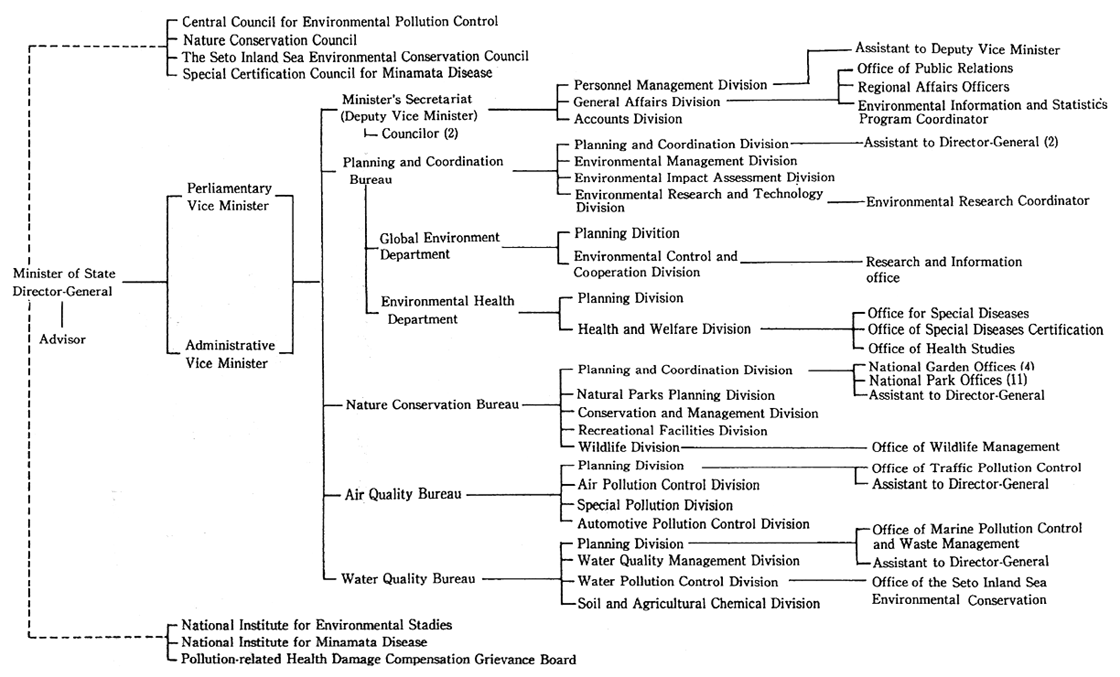
Chart 2. Organization of Central Council for Environmental Pollution Control
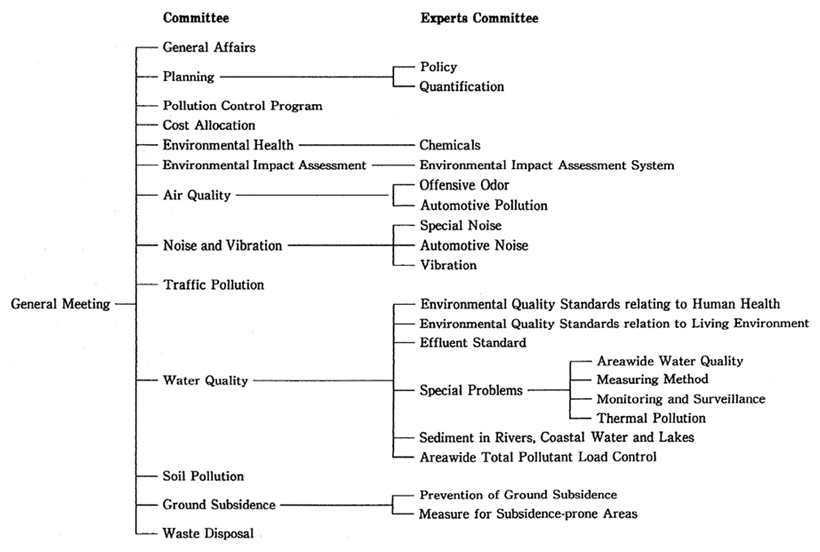
Chart 3. Organization of National Institute for Environmental Studies
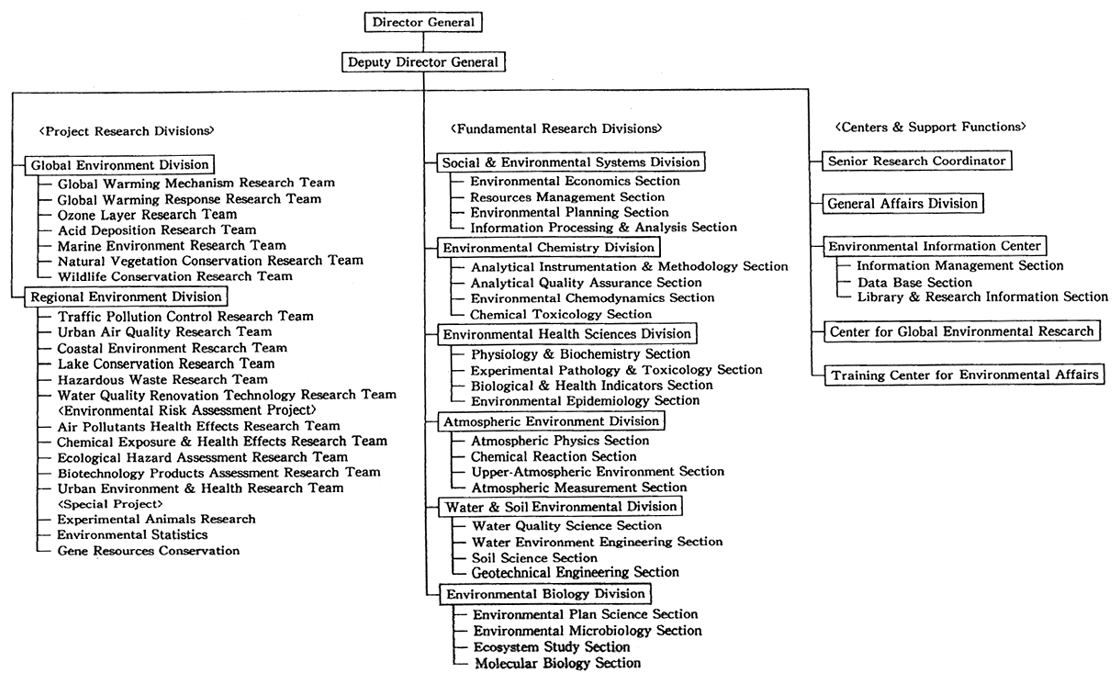
Chart 4. Organization of National Institute for Minainata Disease
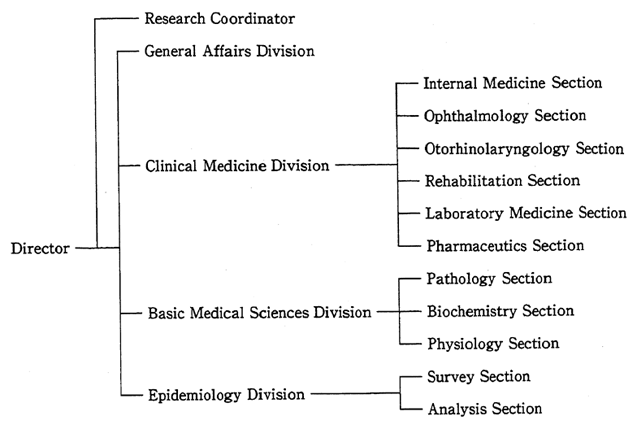
Appendix 2. National Standards
1. Ambient Air Quality Standards
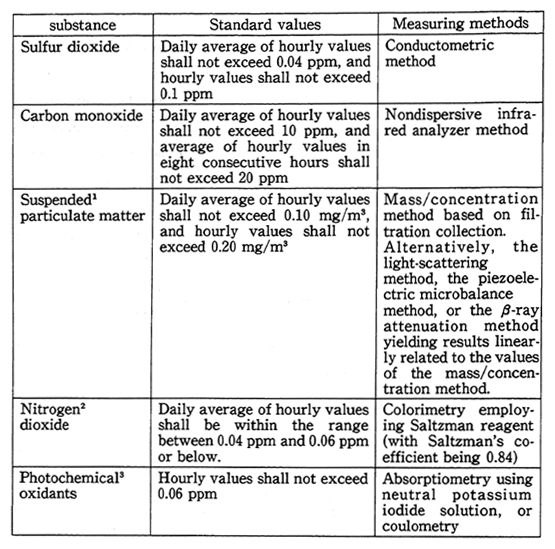
Notes : 1. Suspended particulate matter shall mean airborn paritcles of 10 microns or less in diameter.
2. a) In an area where the daily average of hourly values exceeds 0.06 ppm, efforts should be made to achieve the level of 006 ppm by 1985.
b) In an area where the daily average of hourly values is within the range between 0.04 ppm and 0.06 ppm, efforts should be made so that the ambient concentration be maintained around the present level within the range or does not significantly exceed the present level.
3. Photochemical oxidants are oxidizing substances such as ozone and peroxiacetyl nitrate produced by photochemical reactions (only those capable of isolating iodine from neutral potassium iodide, excluding nitrogen dioxide).
2. Environmental Quality Standards for Noise
(1) Environmental Quality Standards for Noise (including road-side areas)(May 25, 1971)
a. Environmental quality standards
Environmental quality standards values for each type of area and time category shall be as listed in Table 1.
Table 1
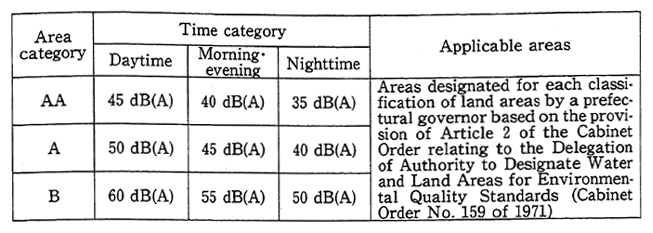
Notes : 1. Area coming within category AA are areas where quiet is specially required such as where there is a concentration of convalescent facilities.
2. Areas coming within category A are areas which are used mainly for residential purposes.
3. Areas coming within category B are areas which are used considerably for residential purposes and which are also used for commercial and industrial purposes.
However, with regard to environmental quality standards for the areas of Table 2 (hereinafter referred to as "areas facing roads"), the values hereinbelow shall be applied instead of the values in Table 1.
b. Method of measurement
The method of measurement of noise, units of measurement, and measuring instrument shall be as follows.
(a) The method of measurement shall conform to the noise level measurement method of Japanese Industrial Standard (JIS) Z8731. In principle, mean values shall be employed in evaluating the measurement results.
(b) The unit of measurement shall be dB (A).
(c) The measuring instrument shall be the indicating noise meter prescribed by JIS C1502 or the precision noise meter prescribed by International Electric Standards Conference (IESC) Pub/179 or equiva-lent instrument.
Teble 2
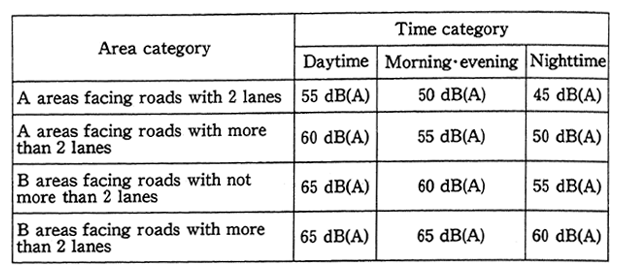
Note : "Lane" refers to a longitudinal strip of road with uniform width requisite to allow a single line of cars to travel therealong safely and without hindrance.
c. Place of measurement
Measurement shall be done outdoors at a point the noise at which is considered to represent the noise of that area as well possible or a point where a noise problem is likely to arise.
In the case of areas facing roads, the measurement point shall in principle be facing the road and one meter toward the road from any building which is used as a residence, hospital, school, or the like.
It is, however, provided that when a building adjoins a road which does not have a sidewalk, measurement shall be carried out at the edge of the road.
Any places such as factory or business establishment sites which generate considerable noise, building construction sites, airport grounds, and railway grounds shall not be used as measurement points.
d. Time of measurement
Measurement shall be done at a time the noise at which is considered to represent the noise of that area as well as possible or a time when a noise problem is likely to arise.
In the case of areas facing roads which are affected mainly by road traffic noise, measurement shall be carried out at least once in the morning and once in the evening and at least twice in the daytime and twice in the nighttime, with special attention being paid to those times at which people get up and go to bed.
e. Period for achieving environmental quality standards
Efforts shall be made to achieve and maintain the environmental quality standards for each type of areas in accordance with the follwing categories and in conjunction with the development of the policies of!.
(a) For areas other than areas facing roads efforts shall be made to achieve the environmental quality standards promptly following the setting of the said standards.
(b) For areas facing roads efforts shall be made to achieve the environmental quality standards within 5 years of the setting of the said standards.
It is, however, provided that for areas facing trunk roads which carry heavy traffic loads making it very difficult to achieve the said environmental quality standards within that time, efforts shall be made to achieve such standards as quickly as possible after the ending of the said 5-year period.
f. Policies for the achievement of environmental quality standards
While the achievement of the environmental quality standards requires the energetic cooperation of the persons who generate the noise, the government shall for its part push forward the following policies in its endeavours to achieve and maintain the said standards. In addition, with regard to the implementation of such policies, appropri-ate measures shall be established to provide fiscal, financial, and tax assistance and special consideration shall be given to small and medium-scale enterprises.
(a) Reinforcement of regulations
With regard to the reinforcement of regulations, when required as part of the achievement of environmental quality standards the regulatory standards relating to factory noise and the permissible limits set for car noise shall be reviewed.
(b) Optimization of land use
Efforts shall be made to optimize land utilization with the basic objective being to separate factories and dwellings, and adjustments shall be encouraged with respect to establishment or expansion of noise-generating factories. In the formulation and implementation of plans for area development full consideration shall be given to the prevention of noise pollution, and in the application of laws relating to land and buildings such as the City Planning Law and the Building Standard Law consideration shall be given to helping to achieve the standard values set out in Article.
(c) Promoting the installation and improvement of noise prevention equipment
In order to make legal controls more effective, the installation of noise prevention equipment and the use of low-noise facilities by fac-tories shall be promoted, and with regard to small-and mediumscale enterprises which have difficulties in carrying out such measures consid-eration shall be given to such enterprises moving into an industrial estate.
In addition, the implementation of such measures to control noise sources shall be accompanied when necessary by the provision of public facilities such as green buffer zones.
(d) Comprehensive policies for road traffic noise
With respect to areas facing roads, in addition to the above measures to control noise, general policies shall be promoted such as improving cars to make them quieter, improving the structure of roads to reduce traffic noise, promoting urban renewal, implementing traffic regulations to the extent that it does not hinder the smooth flow of traffic, and strengthening traffic controls.
In addition, with regard to the construction of new roads, along with other policies aimed at the reduction of road traffic noise full consideration shall be given in the formulation and implementation of the road planning and planned use of land around the roads in order to facilitate the achievement of environmental quality standards in areas facing roads.
(e) Monitoring system
In order to be able to ascertain and evaluate noise accurately for the proper enforcement of regulatory measures, efforts shall be made to provide and reinforce a system with the requisite capability to monitor noise at all times.
(f) Promoting the development of noise-prevention technology
In order to prevent noise pollution, the development of technology for reducing noise for low-noise machinery and vehicles, research and development into noise transmission mechanisms and insulation effects, and research into the effect of noise on the human body shall be promoted.
(g) Assistance for local governments
For the smooth progress of noise control policies local govern-ments shall be given assistance. Special consideration shall be given to the implementation of plans for the control of pollution which are based on the Basic Law for Environmental Pollution Control.
(h) Enlightening the public
The public shall be given the necessary enlightenment to contrib-ute to the prevention of nighttime noise, especially that accompanying latenight business operations and noise accompanying the use of acous-tical equipment and musical instruments in the home.
With regard to road traffic noise particularly strong efforts shall be made to make car drivers conscious about noise prevention and to obtain their cooperation in this respect.
g. Reviewing environmental quality standards
(a) Environmental quality standards shall be modified when neces-sary to reflect advances in knowledge relating to the effect of noise, changes in social evaluation thereof, and the progress of noise measure-ment technology.
(b) Area type designations shall be changed in accordance with changes in the patterns of use of such areas.
h. Exemptions from the application of environmental quality standards
The environmental quality standards herein shall not apply to aircraft, railway, or building construction noise.
(2) Environmental Quality Standards for Aircraft Noise (Dec. 27, 1973)
a. Environmental quality standards
(a) The values of the environmental quality standars are estab-lished for each category of area shown in Table 1. Prefectural governors shall designate the category of area.
(b) The environmental quality standards values referred in para-graph (a) above are measured and evaluated by the following method.
Table 1

Note : Category I area stands for the area for exclusively residential use and category II area for the other area where normal living conditions should be preserved.
1) Peak levels in dB (A) of aircraft noise which is higher than background noise level by 10 dB (A) or more, and the number of such aircraft, should be recorded for, in principle, seven consecutive days.
2) Measurements should be carried out outdoors, at points selected as representing the points of aircraft noise in the area concerned.
3) Timing of measurements should be chosen as representing the duration of aircraft noise at the point of measurements, taking into consideration the flight conditions and meteorological conditions includ-ing wind directions.
4) The aircraft noise shall be evaluated as follws. The WECPNL values for each day will be calculated from peak levels of aircraft noise and numbers recorded under subparagraph 1) above using the following equation. The energy mean of daily WECPNL values thus calculated is the noise level in question.

5)The instrument of measurement to be used in any one of the following: the sound level meter provided for in JIS C-1502, precision sound level meter under IESC Pub/179, or any other equivalent instru-ment.
In these cases, A-weighted calibration and slow dynamic response should be used.
(c) The environmental quality standards provided for in paragraph (a) above shall not apply to areas around airports where there are 10 or less daily landings and take-offs and around those in remote islands.
b. Target dates
(a) In areas around public airports and others, the environmental quality standards shall be attained and maintained before the target dates specified for each category of airports shown in Table 2. In these cases, in the areas where target dates are more than five years away, the improvement goals in Table 2 shall be attained as an interim measure in order to facilitate the attainment of the environmental quality standards step by step.
(b) In areas around airports used by the Self-Defense Forces, etc., efforts shall be made to attain and maintain the environmental quality standards before same target dates as those for category of public airports under similar conditions in Table 2, considering the average number of landings and take-offs, type of aircraft and concentration of houses.
Table 2
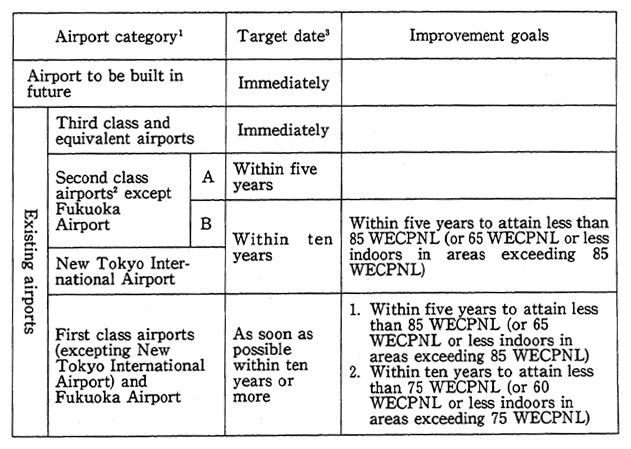
Notes : 1. Airports were categorized as of effective date (December 27, 1973) of these standards.
2. Airports of category B of second class are those where there are regular commercial landings and take-offs of aircrafts equipped with turbo-jet engines, and category A means the others.
3. The target dates are to be counted from the date of establishment of the environmental quality standards
(c) In areas where it is deemed difficult to attain the environmental quality standards before the target dates in spite of the comprehensive measures to be taken to control aircraft noise, such measures should be taken as sound-proofing of the houses of people wishing to remain in the area, with a view to obtaining the indoor conditions effectively equiva-lent to ones where the environmental quality standards are being met, and maximum endeavors shall be made to attain the environmental quality standards as soon as possible.
(3)Environmental Quality Standards for Shinkansen Superexpress Railway Noise (July 29, 1975)
a. Environmental quality standards
(a) The values of the environmental quality standards are establi-shed for each category of area shown in Table 1. Prefectural governors shall designate the category of area.
Table 1

Note : Category I area stands for the area for mainly residential use and category II area for other purposes, including commercial and industrial areas, where normal living conditions should be preserved.
(b) The environmental quality standards values referred in para-graph (a) above are measured and evaluated by the following method.
1) Measurements should be carried out by recording the peak noise level of each of Shinkansen trains passing in both directions, regarding, in principle, 20 successive trains.
2) Measurements should be carried out outdoors and in principle at the height of 1.2 meters above the ground. Those measurement points should be selected, which are seen to represent the Shinkansen railway noise levels in the area concerned, as well as those points where the noise is posing a problem.
3) Measurements are to avoided when special weather conditions prevail and when train speeds are lower than normal.
4) The Shinkansen railway noise should be evaluated by the energy mean value of the higher half of the measured peak noise levels.
5) Instruments that meet the requirements listed in Article 88 of the Measuring Law (No. 207 of 1951) should be used for the measurements, with A-weighted calibration and slow dynamic response.
(c) The environiriental quality standards provided for in paragraph (a) above shall apply to Shinkansen railway noise from 6 a.m. to 12 midnight.
b. Target dates
(a) Efforts shall be made in cooperation with related administra-tions and prefectural governments to attain and maintain the environ-mental quality standards before the target dates specified for each classification of zones along the railway line as shown in Table 2.
In areas where it is deemed difficult to attain the environmental quality standards before the target dates in spite of the comprehensive measures to be takan to control the Shinkansen railway noise, such measures should be taken as sound-proofing of houses, with a view to obtaining the indoor conditions effectively equivalent to one where the environmental quality standards are being met.
When endeavors fail to satisfy the standards within target dates, such efforts are to be continued to attain them as soon as possible.
c. Implementation policy for noise controls
(a) In implementing noise controls for the Shinkansen superexpress railway, "a" areas shall be given priority and special attention.
(b) The methods of implementing noise controls for "b" and "c" areas along existing lines shall reflect the state of progress of policies to overcome obstacles relating to the development and implementation of sound source control technology, the system for such implementation, and financial measures, all with respect to "a" areas.
Table 2
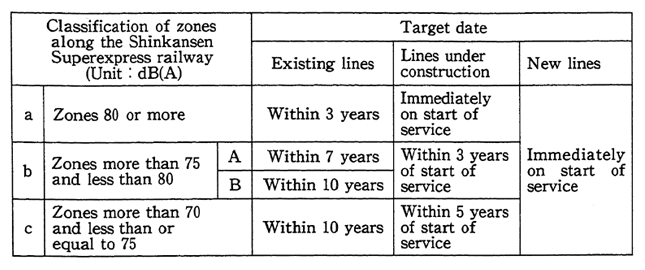
Notes : 1. The subdivision "A" under the "b" classification stands for zones within the region in which there is a succession of category I area, and subdivi-sion "B" stands for zones except subdivision "A".
2. The existing lines, lines under construction, and new lines in the table refer to the following.
(1) Existing Lines: The Tokyo -Hakata section.
(2) Lines Under Construction : The Tokyo -Morioka, Omiya -Niigata. and Tokyo -Narita sections
(3) New Lines: New lines being those other than the lines of (1) and (2) above
3. With respect to existing lines, the target dates for achievenment are calcu-lated from the date when the environmental quality standards are estab-lished.
3. EnvironmentalWater Quality Standards (Dec. 28, 1971, Amendments 1974, 1975, 1982, 1985)
(1) Standards related to the Protection of Human Health
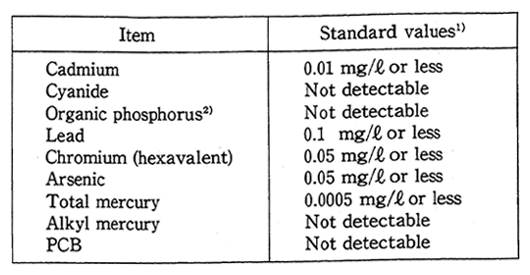
Notes: 1. Maximum values. But with regard to total mercury, standard value is based on the yearly average value.
2. Organic phosphorus includes parathion, methyl parath-ion, methyl demeton and E. P. N.
3. Standard value of total mercury shall be 0.001 mg/i in case river water pollution is known to be caused by natural conditions.
(2)Standards related to the Coservation of the Living Environment
a. Rivers
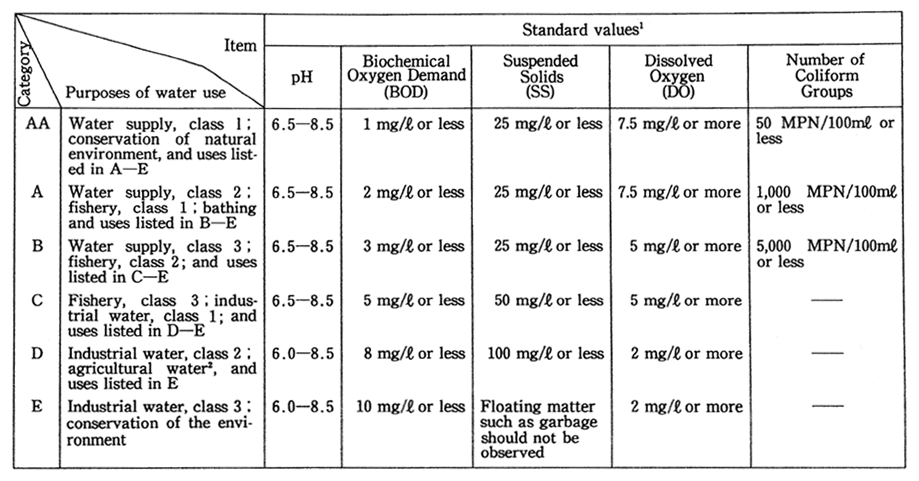
Notes : 1. The standard value is based on the daily average value. The same applies to the standard values of lakes and coastal waters.
2. At the intake for agriculture, pH shall be between 6.0 and 75 and dissolved oxygen shall not be less than 5 mg/ l. The same applies to the standard values of lakes.
3. Conservation of natural environment Conservation of scenic spots and other natural resources.
4. Water supply, class 1-Water treated by simple cleaning operation, such as filtration. Water supply, class 2-Water treated by normal cleaning operation, such as sedimentation and filtration. Water supply, class 3-Water treated through a highly sophisticated cleaning operation including pretreatment.
5. Fishery, class 1-For aquatic life, such as trout and bull trout inhabiting oligosaprobic water, and those of fishery class
2 and class 3. Fishery, class 2-For aquatic life, such as fish of the salmon family and sweetfish inhabiting oligosaprobic water and those of fishery class 3. Fishery, class 3-For aquatic life, such as carp and crucian carp inhabiting ,fタ-mesosaprobic water.
6. Industrial water, class 1-Water given normal cleaning treatment such as sedimentation. Industrial water, class 2-Water given sophisticated treatment by chemicals. Industrial water, class 3-Water given special cleaning treatment.
7. Conservation of the environment-Up to the limits at which no unpleasantness is caused to people in their daily life including a walk by the riverside, etc.
b. Lakes (natural lakes, and artificial reservoirs with 10 million cubic meters of water or above)
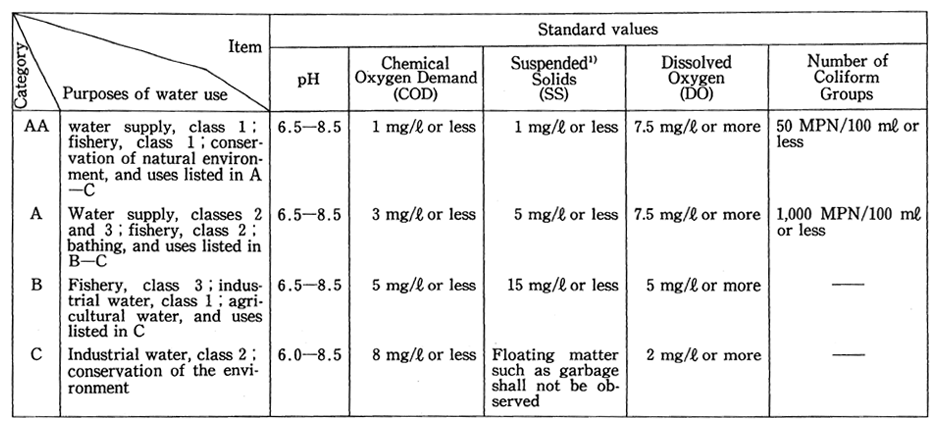
Notes : 1. With regard to fishery, classes 1, 2 and 3, the standard value for suspended solids shall not be applied for the time being.
2. See notes for rivers.
3. Fishery class 1-For aquatic life,such as salmon inhabiting oligotrophic lake type waters, and for those of fishery class 2 and 3.
Fishery class 2-For aquatic life, such as fish of the salmon group and sweet fish inhabiting oligotrophic lake type waters, and for those of fishery class 3.
Fishery class 3-For those aquatic life, such as carp and silver carp inhabiting eutrophic lake type waters.
4. Industrial water class 1-Water given normal treatment such as sedimentation. Industrial water class 2-Water given sophisticated treatment such as chemical injection or special treatment.
5. Conservation of the environment-Up to the limits at which no unpleasantness is caused to the people in their daily lives including a walk along the shore.
c. Nitrogen and phosphorus in lakes and reservoirs
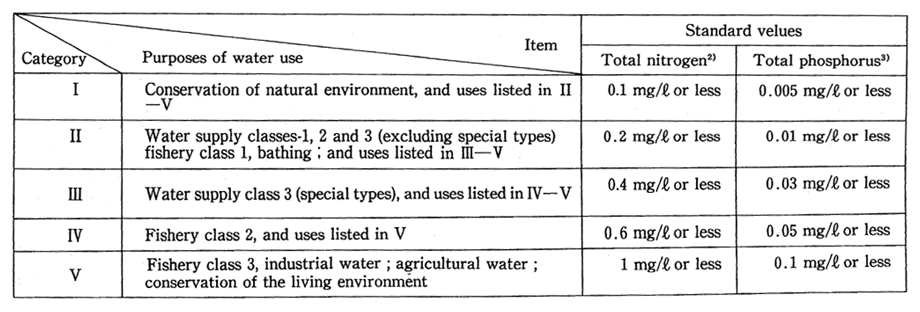
Note : 1. Standard values are set in terms of annual averages.
2. Standard values for total nitrogen are applicable to lakes and reservoirs where nitrogen is a causal factor of the growth of phytoplankton.
3. Standard values for total phosphorus are not applicable to agricultural water uses.
4. Conservation of natural environment-Conservation of scenic points and other natural resources
5. Water supply class 1-Water treatment by simple cleaning operation such as filtration.
Water supply class 2-Water treatment by normal cleaning operation such as sedimentation and filtration.
Water supply class 3-Water treatment by sophisticated cleaning operation including pretreatment. ("special types" mean water treatments by special cleaning operation in which removal of smelling substances is possible.)
6. Fishery class 1-For aquatic life, such as fish of the salmon group and sweet fish, and for those of fishery class 2 and 3.
Fishery class 2-For aquatic life, such as smelt and for those of fishery class 3.
Fishery class 3-For aquatic life, such as carp and silver carp.
7. Conservation of the environment-Up to the limits at which no unpleasantness is caused to the people in their daily lives including a walk along the shore.
d. Coastal waters

Notes : 1. With regard to the water quality of fishery, class 1 for cultivation of oysters, the number of coliform groups shall be less than 70 MPN/100 ml.
2. Conservation of natural environment-Conservation of scenic points and other natural resources.
3. Fishery, class 1-For aquatic life, such as red sea-bream, yellow tail, seaweed and for those of fishery class 2.
Fishery, class 2-For aquatic life, such as gray mullet, layer, etc.
4. Conservation of the environment-Up to the limits at which no unpleasantness is caused to the people in their daily lives including a walk along the shore.
4. National Emission Standards
(1) Sulfur Oxides
a. Sulfur oxides emission standard
The emission standard for sulfur oxides which applies to a given sulfur oxides emitting facility may be calculated by inserting a value K, specified under Cabinet Order for the region that the facility is located, into the following equation:
q = K× 10-3 × He2
Here, q is the hourly volume of sulfur oxides emitted (in unit of Nm and He, effective height of stack, is the sum of actual height of stack and smoke ascent height. The value of K, which varies according to the region, inversely determines the degree of regulation. In other words, a reduction in K means stiffer control standard. The standard for sulfur oxides has hence been labeled the "K-value regulation."
The general emission standard for sulfur oxides (the K-value) was strengthened on September 28, 1976,and as a result all of Japan now controlled under sixteen K ranks ranging from 3.00 to 17.5.
b. Regulation on fuel
The regulation on fuel quality under the Article 15 of the Air Pollution Control Law was revised in September 1976. Asahikawa was added to the previous list of 14 areas (Tokyo, Osaka, etc.).
The regulation standards were upgraded to a sulfur content ranging from 0.5 to 1.2%. Regulation of Sulfur Oxides Emission (K-value)
(a) General standards
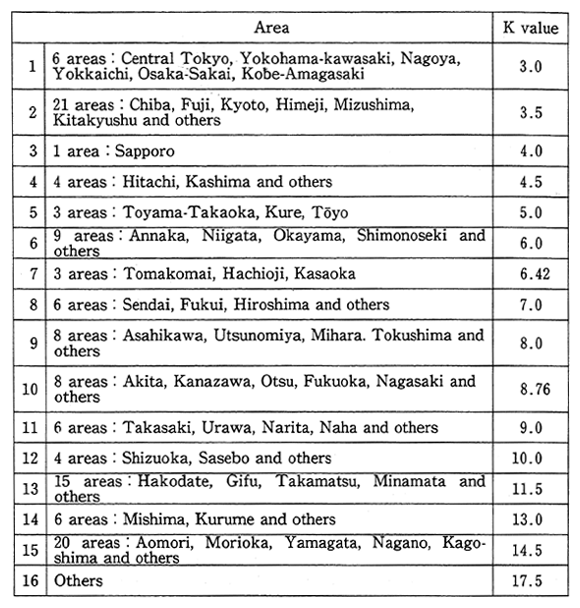
(b) Special standards

Note : Special standards are applied to newly constructed facilities only.
(2) Soot and Dust (Latest amendment, May 1982)
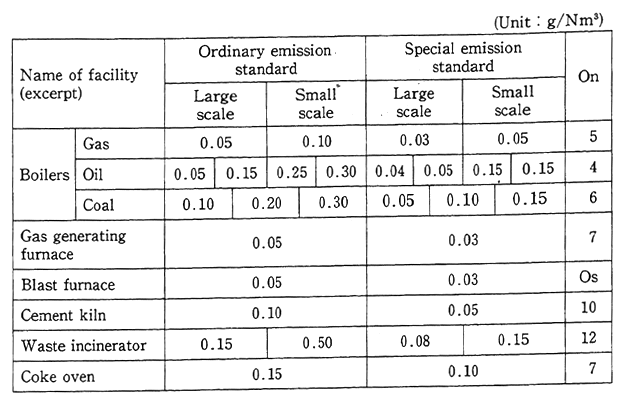
Notes: 1. Prefectures may, by decree, set more stringent standards.
2. The gas emission rate of 40,000 Nm3/h is the criterion used for scale classification. However, heavy oil boilers and coal boilers are classified into four and three scales respectively. The criteria for the former ones are 200,000 Nm3/h, 40,000 Nm and 10,000 Nm3/h, and 200,000 Nm3/h and 40,000 Nm3/h are for the latter ones.
3. The emission concentration shall be converted through the following equation. (Except in the case of blast furnace)
C = (21-On)/(21-Os)× Cs
C : Soot and dust emission concentration
On : Oxygen concentration in flue gas (set values in the above table)
Os : Actual oxygen concentration in flue gas
Cs : Actual soot and dust emission concentration
(3) Harmful Substances (June 22, 1971)
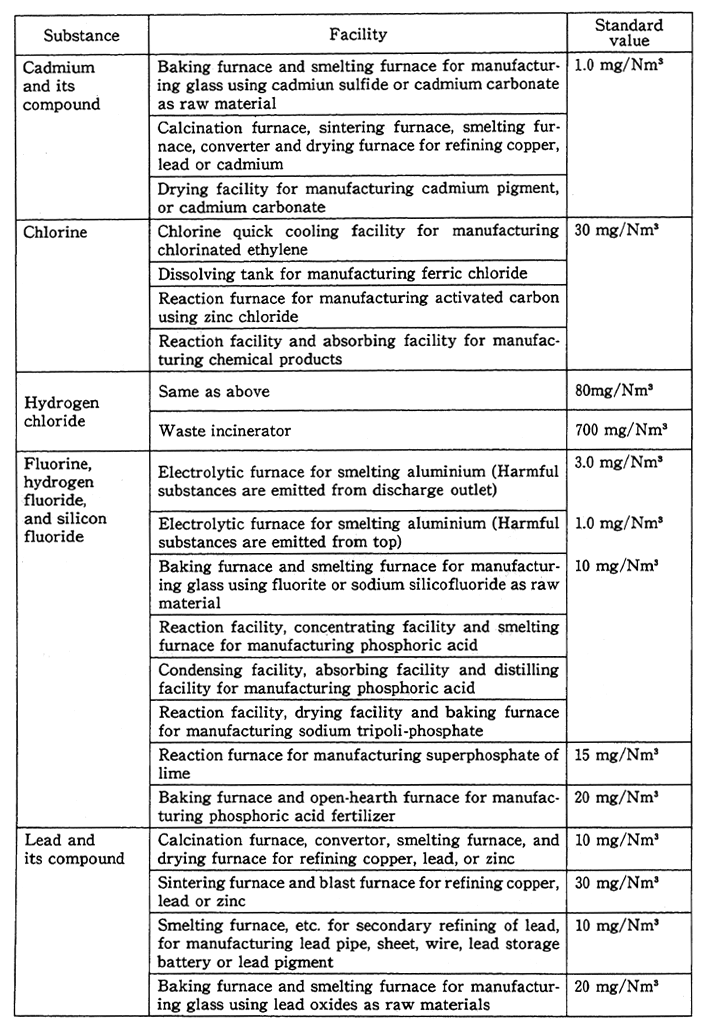
Note : Prefectures may, by decree, set more stringent standards.
(4) Nitrogen Oxides (as of Sept. 1983) (Abstract)

(contd.)
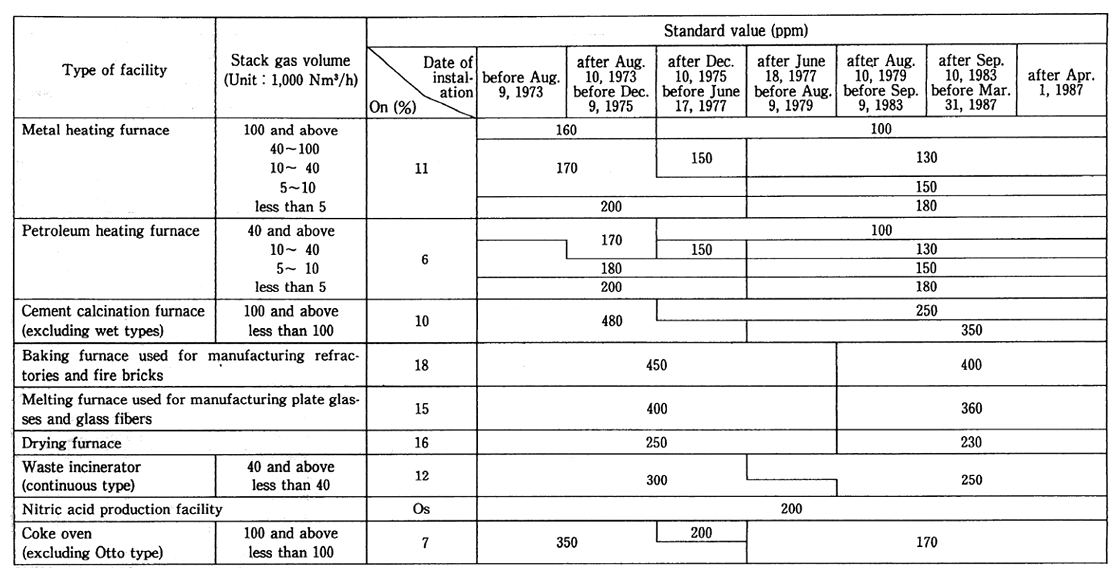
Notes: 1. Reference to unit, the symbol " -" means "and above/less than": e.g. a -b means a and above/less than b.
2. NOX emission concentration shall be converted through the following equation. (Except in the case of nitric acid production facilitie)
C = Cs.
C : Nitrogen oxides emission concentration
On : Oxygen concentration in flue gas (set values in the above table)
Os : Actual oxygen concentration in flue gas
Cs : Actual nitrogen oxides emission concentration
(5) Asbestos (December 1989)
The regulatory standards for asbestos requires an average asbes-tos fiber level at boundary lines of asbestos manufacturing plants less than 10 fiber 1 liter.
(6) Offensive Odor Substances (Latest revision, September 1976)
a. Range of regulatory standards on boundary line
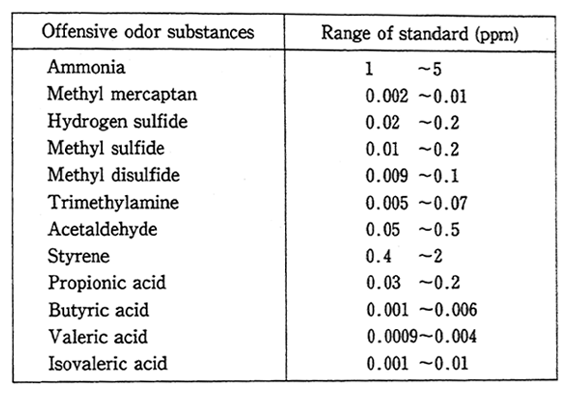
b. Regulatory standards at the outlet*
(Excluding methyl mercaptan, methyl sulfide, methyl disulfide, acetaldehyde and styrene)
q = 0.108 × He2ECm
q : Gas emission rate (Unit: Nm3/hr)
He: Effective height of outlet (Unit: m)
Cm: Regulatory standard on boundary line (Unit: ppm)
* These standards apply to those outlets which are higher than five meters.
(7) Permissible Limits of Motor Vehicle Exhaust Gas
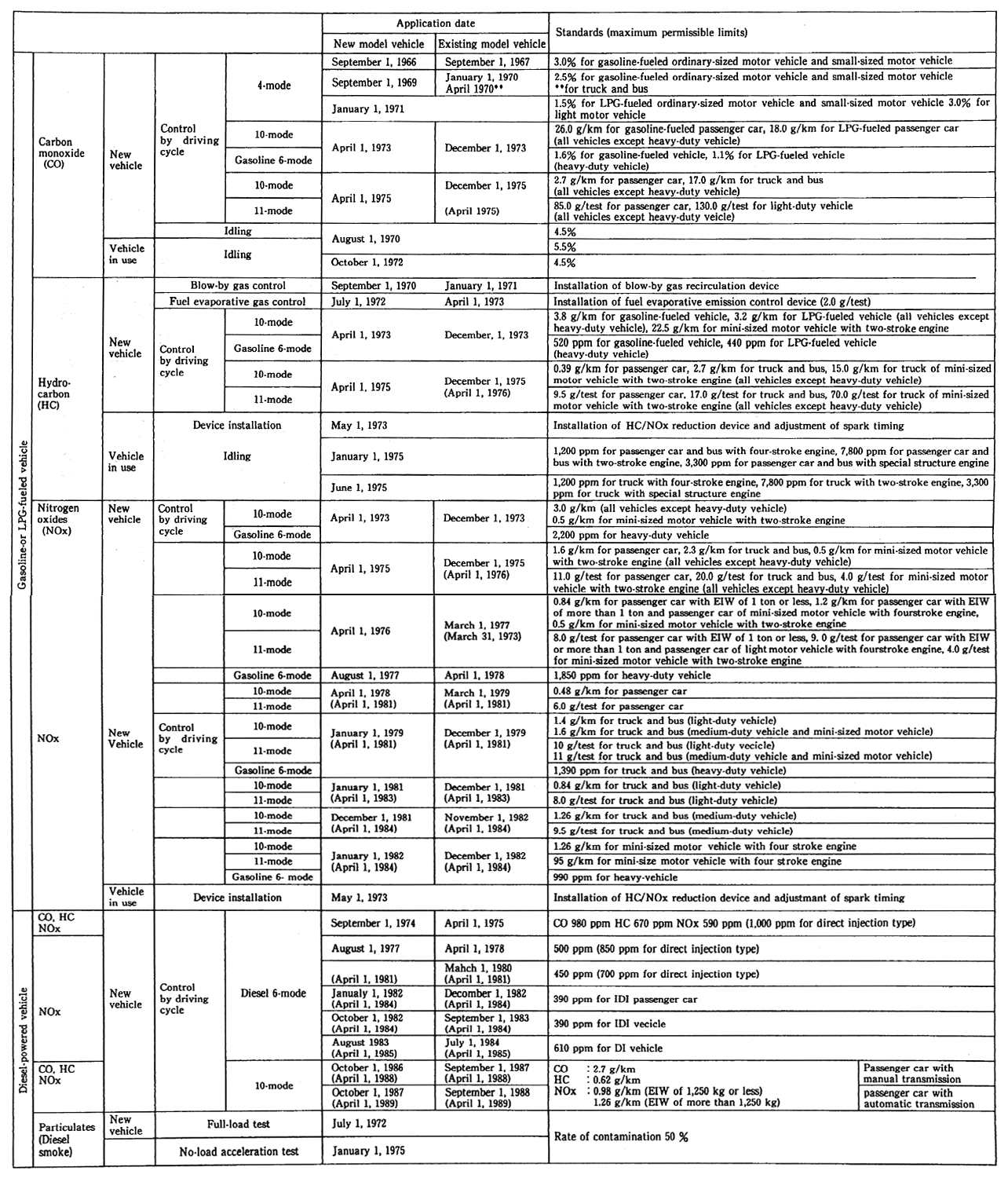
5. National Effluent Standards (June 21, 1971; Amendments 1974, 1975, 1976, 1977, 1981, 1985, 1986)

(1) Substances related to the Protection of Human Health1)
Notes : 1. Prefectures may, by decree, set more stringent standards.
2. By the term "not detectable" is meant that the substance is below the level detectable by the method designated by the Director-General of the Environment Agency
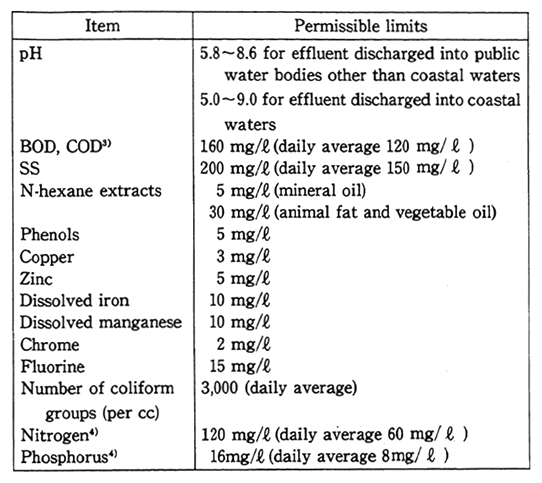
(2) Items related to the Protection of Living Environment
Notes : 1. Prefectures may, by decree, set more stringent standards.
2. The standard values in this table are applied to the effluents from industrial plants and other places of business whose vol-ume of effluents per day is not less than 50m3.
3. The standard value for BOD are applied to public waters other than coastal waters and lakes, while standard value for COD is applied only to effluents discharged into coastal waters and lakes.
4. Standard values for nitrogen and phosphorus are applied to lakes and reservoirs in which problems due to eutrophication may occur.
The phosphorus standards are applicable to lakes and reservoirs where water stays for 4 days or longer (excluding those with a chlorine ion content of more than 9,000 mg/l and those where special dam operations are conducted) out of lakes and reser-voirs with a drainage area of more than 1 Km a total surface area of more than 0.1 Km limitation does not apply to lakes and reservoirs used as source of tap water). Also covered are rivers and other water bodies designated as "public water areas" flowing into the above lakes and reservoirs.
The nitrogen standards are applicable to lakes and reservoirs where the figure obtained by dividing the nitrogen content of water by the phosphorus content is less than 20 and the phospho-rus content of water exceeds 0.02 mg/l out of the lakes and reservoirs subject to the phosphorus regulation. Also covered are rivers and other water bodies designated as public water areas flowing into those lakes and reservoirs.
Appendix3: Environmental Statistics
1. Budget and Public Financing
Table 1. Budget for Environmental Conservation by Ministries and Agencies (Initial)
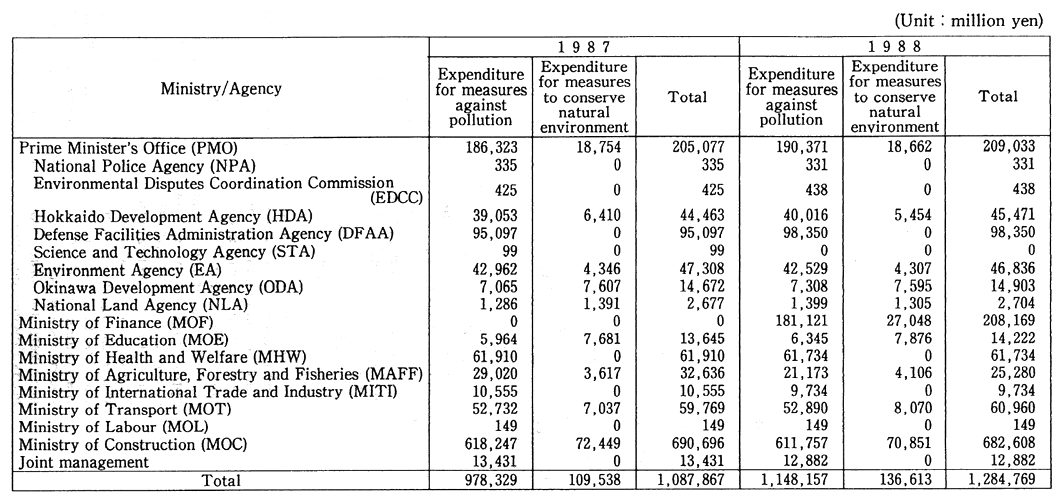
Notes: 1. The expenditure allocated under operating programs are excluded.
2. There are cases in which a simple addition of all figures does not coincide with a figure in "Total," as fractions of 5 and over are counted as a unit and the rest is cast away.
Table 2. Budget for Conservation of Environment by Item (Initial)
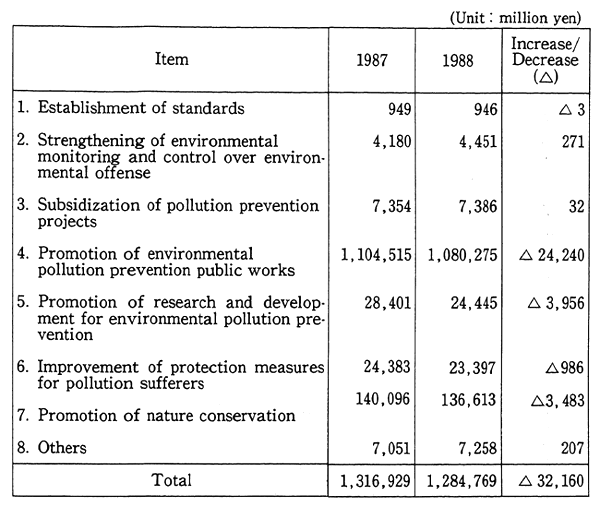
Notes: 1. The expenditure allocated under operating programs are excluded.
2. There are cases in which a simple addition of all figures does not coincide with a figure in "Total", as fractions of 0.5 and over are counted as a unit and the rest is cut off.
Table 3 Expenditures for Pollution Control Projects Associated with Institutions Eligible for Financial Investments and Loans (Initial Plan)
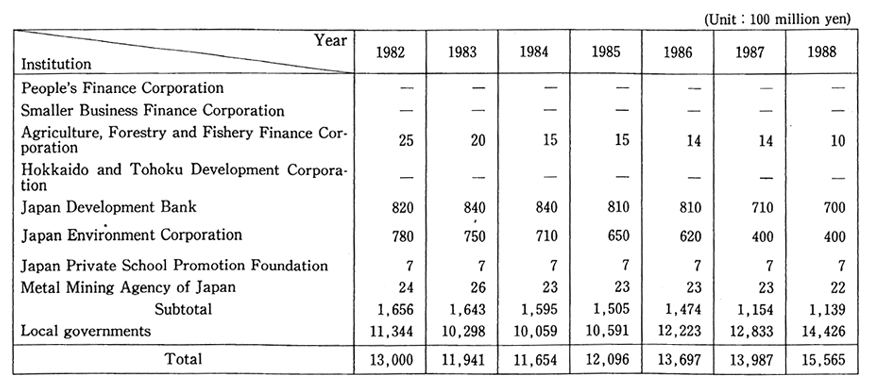
Notes: 1. "-" denotes the expenditures in which only those related to measures against pollution cannot be taken out because the framework of financial investments and loans is set up while they are combined with loans and projects for other purposes.
2. Necessary loans are also advanced by the Environmental Sanitation Business Finance Corporation, Okinawa Development Finance Corporation, Maritime Credit Corporation and Small Business Promotion Corporation.
Table 4 Project Scale of Japan Environment Corporation
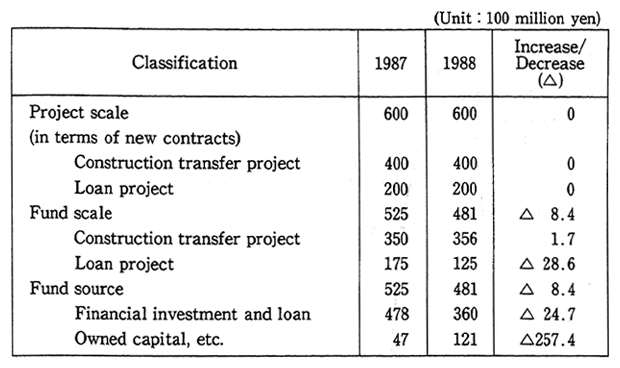
Table 5 Cost for Pollution Prevention Projects covered by Enterprises
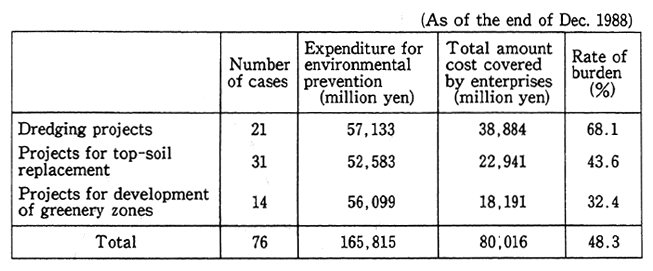
Notes:1. It is stipulated in Article 22 of the Basic Law for Environmental Pollution
Control that in relation to projects to be carried out by the State or the local governments, an enterpreneur shall bear all or part of the cost required for the project, depending on the degree to which his business activities are deemed causative, in order to prevent the environmental pollution which might be caused by his business activities.
2. As there are projects in which a dredging project and a project for the development of green buffer zone are carried out, the number of cases by project does not coincide with the total number of cases.
3. The expenditure for projects to prevent environmental pollution and the total amount of burden by enterpreneurs are those on a planning basis.
Fig 1. Trends in Anti-pollution Investment by Big Enterprises
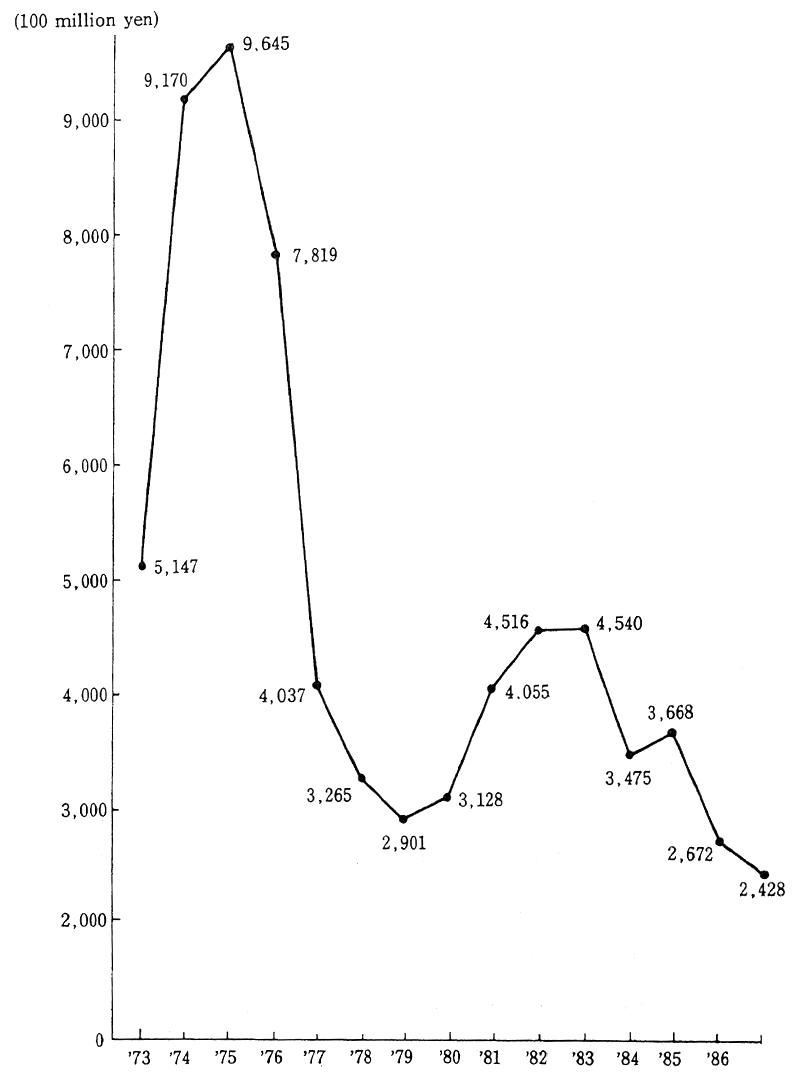
Note : Those enterprises surveyed are manufacturers and other firms with capital of ¥100 million or more.
Source : Survey by the Ministry of International Trade and Industry
2. Settlement of Pollution-related Disputes and Police Handling of Pollution Offences
Table 6 Overview of Pollution-related Disputes
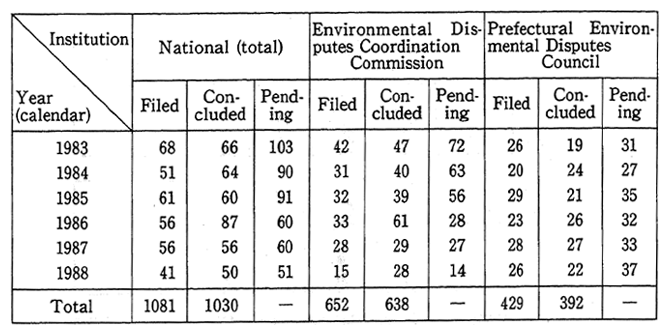
Note : The total for the period (calendar years) is that of the period extending from November 1, 1970 to December 31, 1987.
Source: Environmental Disputes Coordination Commission
Fig. 2 Trends of Pollution-related Complaints
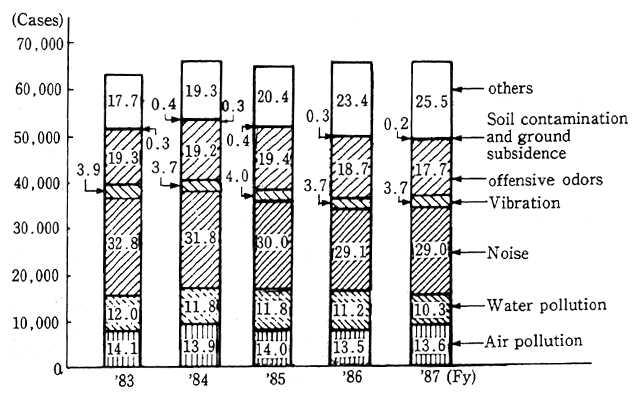
Source: Environmental Disputes Coordination Commission
Fig. 3 Changes in Number and Ratio of Complaints by Source
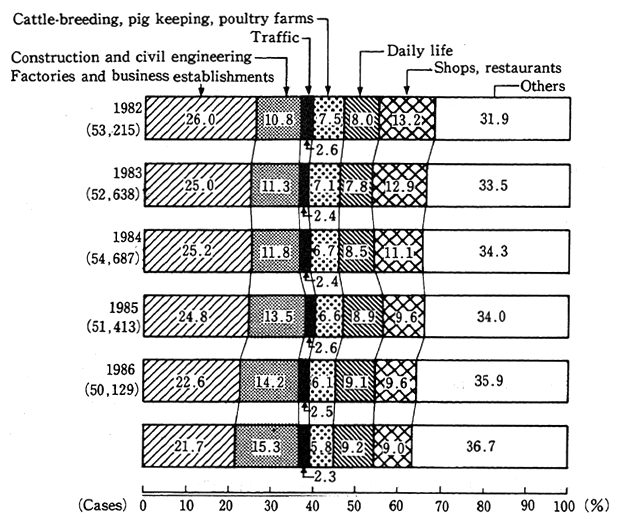
Source: Environmental Disputes Coordination Commission.
Table 7 Environmental Pollution Complaints Filed with Police (1988)
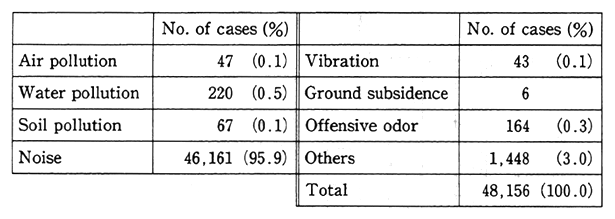
Source: Survey of the National Police Agency 1987 (51,665)
Table 8 Police Handling of Environmental Pollution Complaints (1987)

Source: Survey of National Police Agency
Fig.4 Number of Arrest of Pollution Offense (1984 -1988)
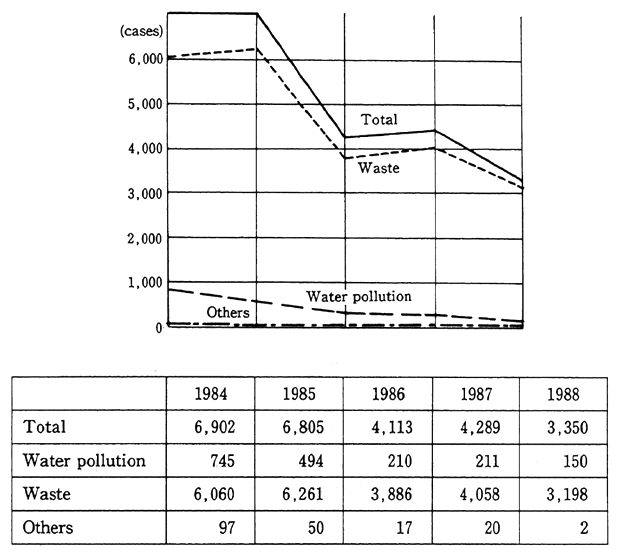
Note : Offenses of air pollution, soil pollution, noise, vibration and offensive odor are included in "others."
Source Survey of National Police Agency
Table 9 Breakdown of Violation concerning Marine Pollution
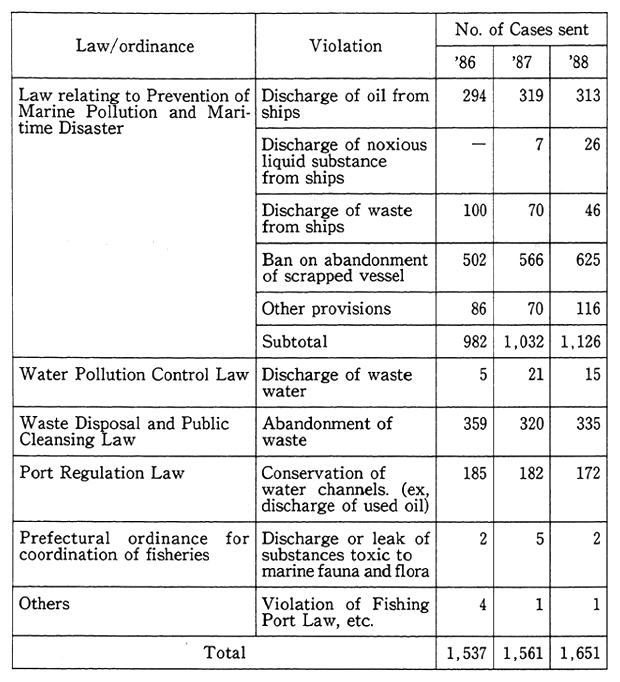
Source Survey of Maritime Safety Agency
Table 10 Breakdown of Violation of Waste Disposal and Public Cleansing Law (1988)

Source: Survey of National Police Agency
3. Major Nature Reserves and Natural Parks
Fig. 5 Location of National Parks, Quasi-National Parks, and Nature Conservation Areas
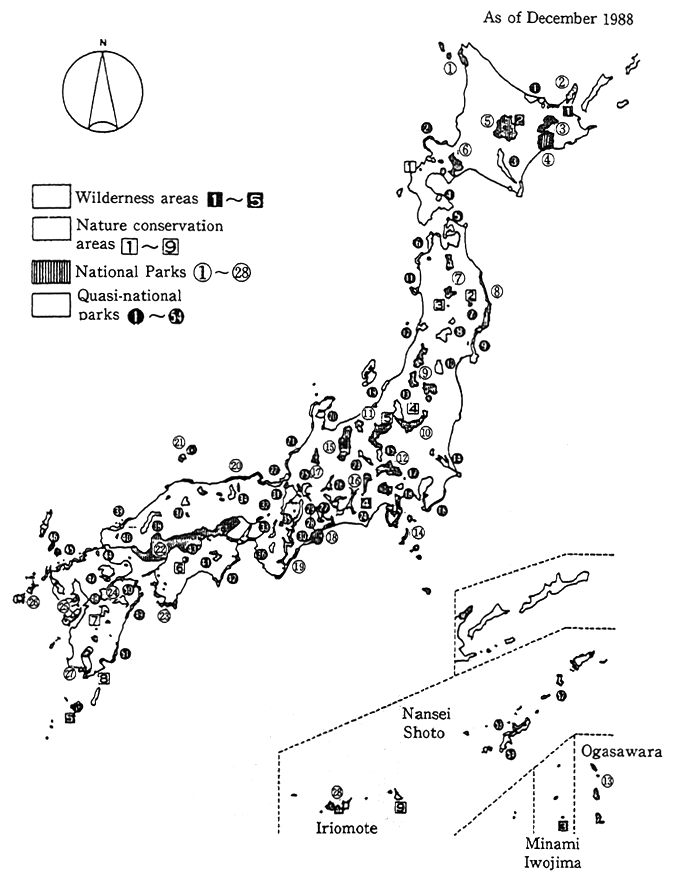
Table 11. Wilderness Areas
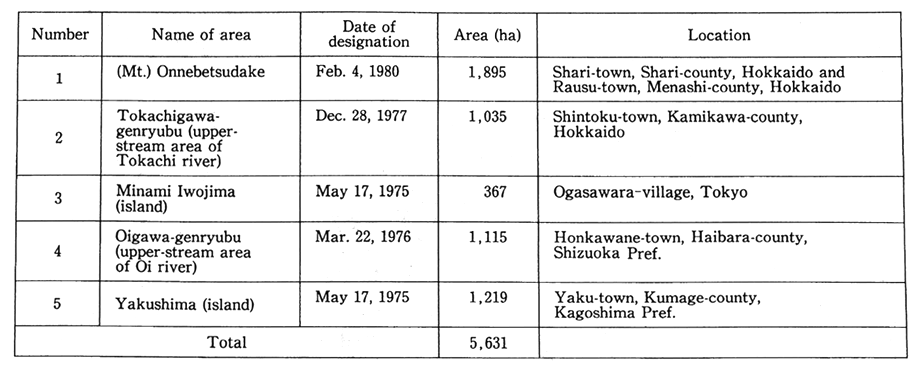
Table 12 Nature Conservation Areas
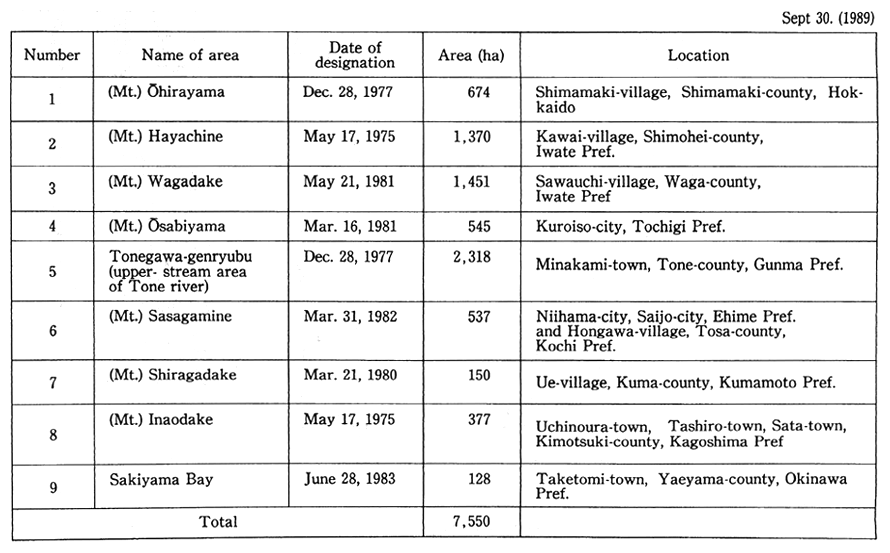
Table 13 National Parks
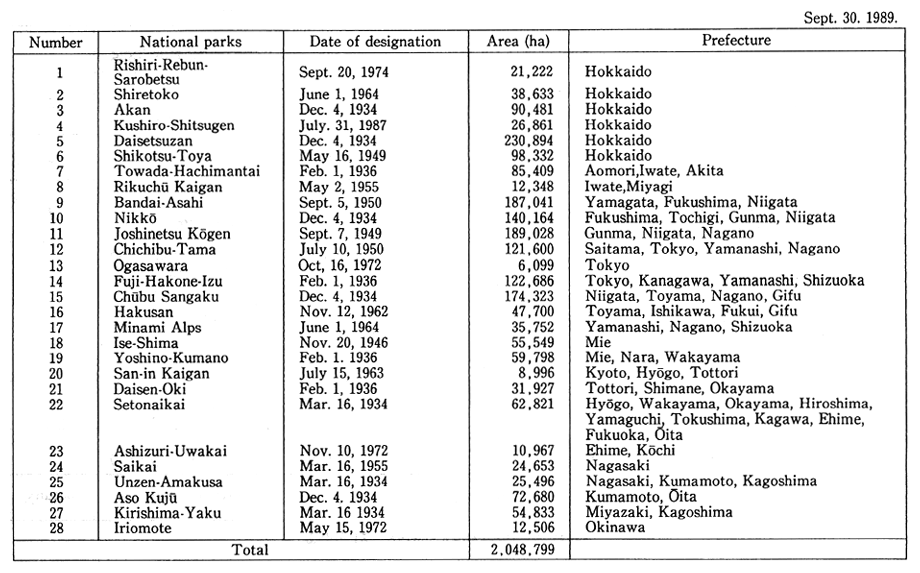
Table 14. Quasi-National Parks
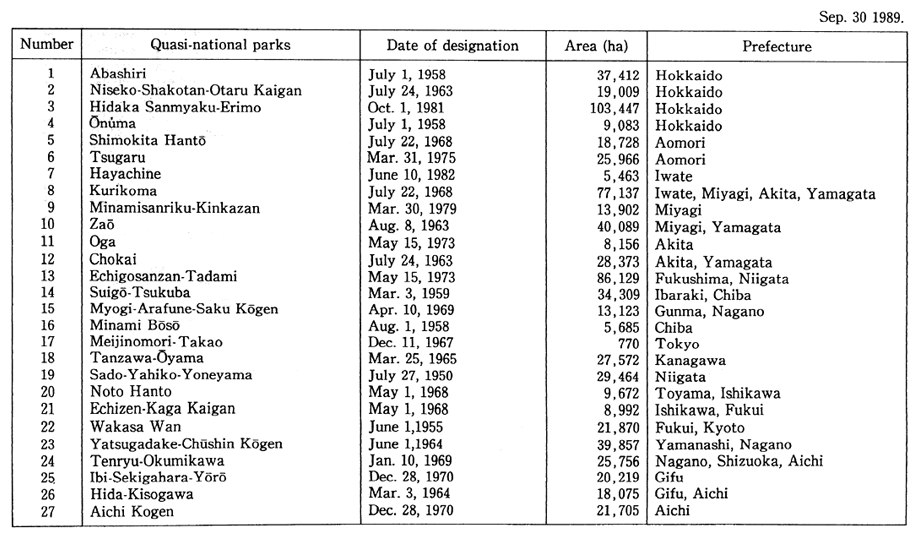
Table 14. (contd.)
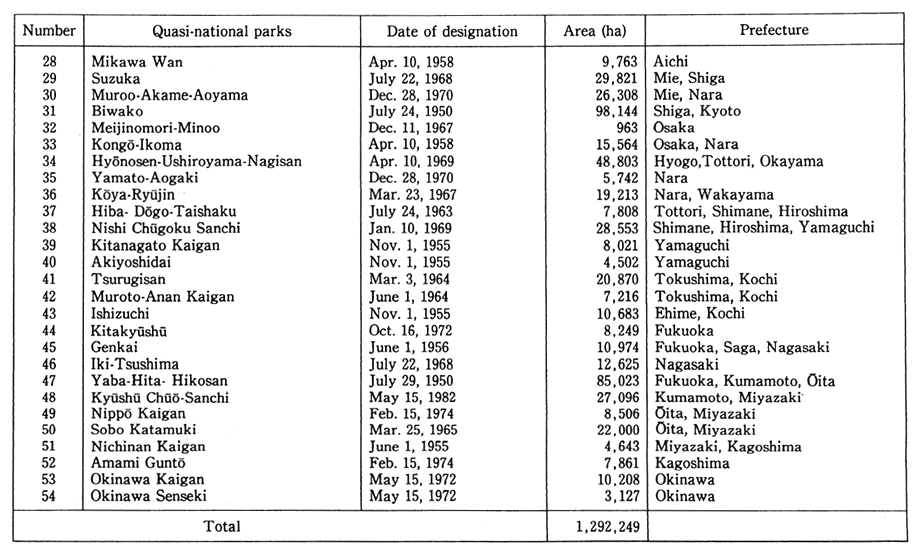
4. Environmental Administration by Local Government
(1) Manpower
Table 15 Number of Prefectural Personnel Responsible for Pollution Control

Note : The number of Part-time person is calculated by dividing the number of person who co-employed in the other job at the rate of the quantity of the person's job.
Table 16 Number of Prefectural Personnel Responsible for Nature Conservation

Note : The number of Part-time person is calculated by dividing the number of person who co-employed in the other job at the rate of the quantity of the person's job.
Table 17 Number of Municipal Personnel Responsible for Pollution Control (Full-Time only)
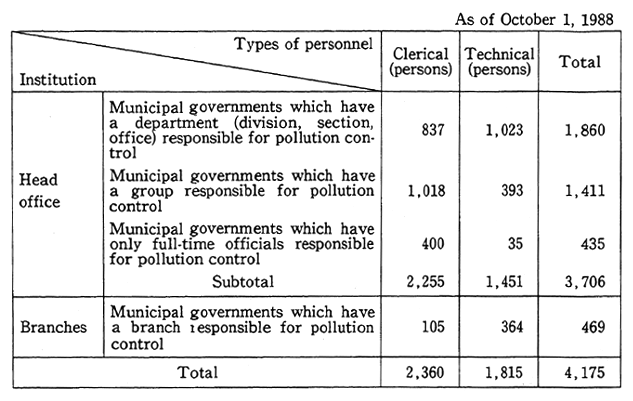
(2) Budget and Public Financing
Table 18 Budget for Environmental Pollution by Local Governments in 1987 (Final)
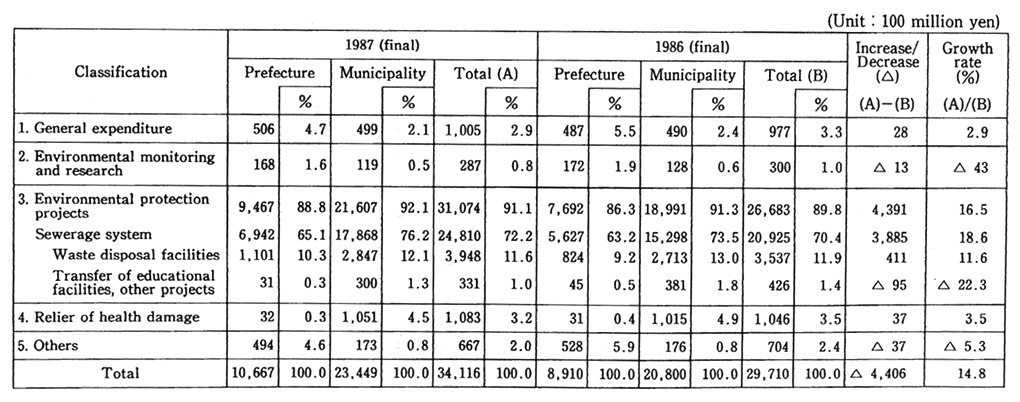
Note: The "budget (final)" is gained by deducting duplications between the prefecture and municipality.
Source: Survey of Ministry of Home Affairs
Table 19 Financial Assistance for Pollution Control Facilities by Local Governments (1987)

Table 20 Subsidies for Pollution Control Facilities by Local Governments (1987)

(3) Ordinance and Environmental Agreement
Table 21 State of Enactment of Ordinances for Environmental Conservation in Municipal Governments

Table 22 Number of Pollution Control Agreements by Types of Industries
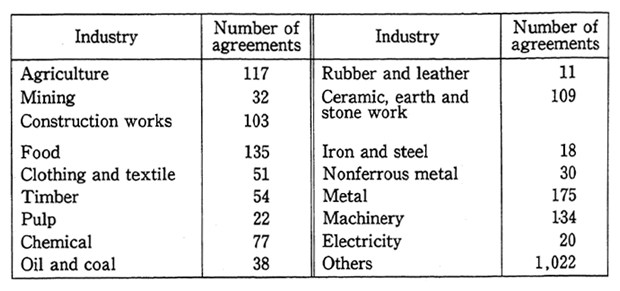
Note: The breakdown of the agreements concluded from October 1, 1987 to September 30, 1988.
Table 23 Details of Pollution Control Agreements

Note : The breakdown of the agreements concluded from October 1, 1987 to September 30, 1988.
Table 24 Residents' Participation in Pollution Control Agreements

Note : The breakdown of the agreements concluded from October 1, 1987 to September 30, 1988. Under an environmental pollution control agreement, it is possible to carry out measures against environmental pollution in an elaborated manner, depending on the geographical and social conditions of the given community. From the standpoint of a business, it would be virtually impossible to operate a plant without a consent of the community residents at the time of its location.
5. Environmental Monitoring
Air (As of March 1987)
Table 25 Air Pollution Monitoring
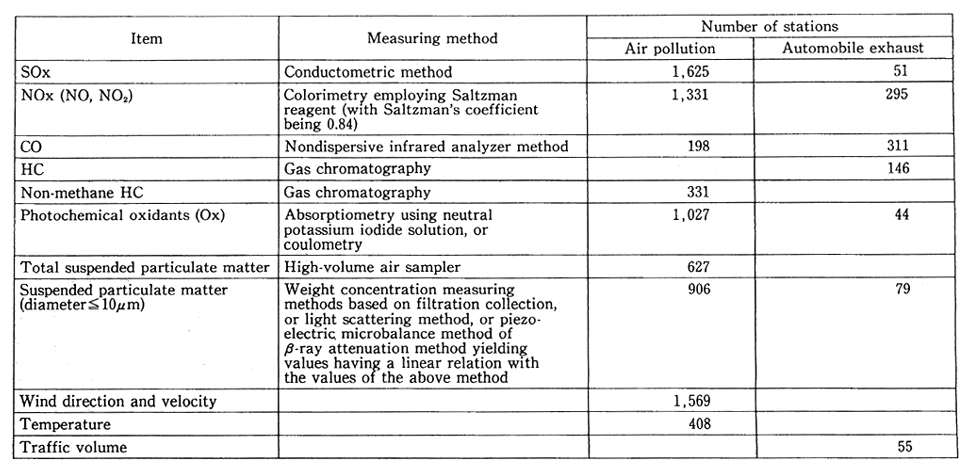
Appendix4.
Major Environmental Events from April 1988 through March 1989 (FY 1988)
Date Events
1988
Apr 19 E The 46th Meeting of the OECD Environment Committee (Paris April 19-21).
28 E The Environment Agency releases a "Fundamental Plan to Make the Low Pollution Cars Prevailing".
May 10 The Environment Agency requests the ministries and orga-nizations concerned to promote the measures to comply with the Environmental Standard on the Shinkansen Rail-road Noise.
20 E Cabinet Decision on the White Paper on the Environment 1988 (annual report) -Global Environmental Problems and Japan's Contribution and its submission to the Diet. Promulgation of the Law Concerning Preservation of the Ozone Layer by Restricting Designated Substances.
June 2 E The Environment Disputes Coordination Commission medi-ates the case of damages by the dust from studded tires.
5 "Summit in the City under Starry Heavens and Blue Skies (sponsored by the Environment Agency and the Kita-kyusyu Municipal Government) is held in Kita-kyusyu city.
17 E The Council on Global Environmental Problems releases the report entitled "Approach of This Country to the Global Environmental Problems-Japan's Contribution-Aiming at a Better Global Environment".
July 8 E Japan and China agree to the project of JICA to protect wild crested ibises living in China etc.
19 E Promulgation of the Cabinet Order partially amending the Implementation Order for the Law relating to Prevention of Marine Pollution and Maritime Disaster (Additional regula-tion of pollution caused by wastes generated in ships, com-pliance with the Annex of the MARPOL 73/78 Convention).
25 The Environment Agency releases the result of "the Animal Distribution Survey" carried out according to the 3rd National Survey on Preservation of Natural Environment.
Aug. 4 E The Environment Agency releases the report on the effect of dust from studded tires on human health.
10 E The Environment Agency releases the summary of the result of Biological Monitoring Survey (TBT compounds) carried out in 1987 FY.
13 E General-director of the Environment Agency visits and exchange opinions with the Administrators of EPA and NASA of US, the Minister for Energy, Mines and Resources of Canada.
25 E Prime Minister Takeshita visits China and announces his intention to promote cooperative projects in the field of the environment.
26 E Promulgation of the Cabinet Order partially amending the Implementation Order for the Water Pollution Control Law and the Implementation Order for the Law Concerning Special Measures for Conservation of the Seto Inland Sea. (Adding the regulation on communal kitchens, lunch caterer's shops, restaurants and etc.). The Environment Agency releases the result of investiga-tion on the seasonal air pollution control measures.
Oct. 3 E The 4th Japan-France Meeting on Amenity-aiming at the recreation of cities-is held in France (-10).
Nov. 1 E The National Yatsu Wildlife Protection Area and the National Hama-kosien Wildlife Protection Area are estab-lished by the Environment Agency.
2 E The Environment Agency releases the 1st Interim Report of the Investigation Group on Global Warming.
9 E The 1st Meeting of IPCC (Intergovernmental Panel on Climate Change) is held in Geneva (-11).
22 E The 4th Japan-China Migratory Birds Protection Confer-ence is held in Beijing.
Dec. E Air Pollution Prevention Month (December).
1 E The Environment Agency starts "NO2 Forecasting Project" broadcasted by television and radio (-27).
7 E The 47th meeting of the OECD Environment Committee (Paris-9).
15 E The Environment Agency releases the report on the State of Emissions of Trichloroethylene and others, and the State of Groundwater Pollution.
16 E The Environment Agency releases the result of the National Star Watching in Summer.
20 E The Japan-Soviet Migratory Birds Protection Treaty takes effect.
E Promulgation of the Ordinance of the Prime Minister's Secretariat partially amending the Implementation Ordi-nancefor the Law relating to Regulation of Transfer of the SpecialBirds (23 species of birds in the Soviet Union added to the list of special birds under protection).
23 E The Environment Agency issues the "New Middle-Term Outlook on Measures for Nitrogen Oxides in Large Cities".
29 E The Vienna Treaty for Preservation of the Ozone Layer takes effect in Japan.
1989
Jan. 1 E The Montreal Protocol Concerning Ozone Layer Dis-truptive Substances takes effect in Japan.
4 E The Environment Agency and the MITI announce the "Basic Matters for Preservation of Ozone Layer", and the "Guideline for Restriction of Discharge of and Rationaliza-tion of Use of Designated Frons".
13 E The Environment Agency releases the results of the "Botan-ical Stock Survey and Designated Botanical Stock Survey" carried out according to the 3rd National Survey on Preser-vation of Natural Environment.
31 E The Prime Minister designates Lake Naka-no-umi and Lake Shinji as the Designated Lakes under the Law Con-cerning Special Measures for the Preservation of Lake Water Quality.
Feb. 17 E Promulgation of the Law partially amending the Law Concerning National Holiday (April 4th is designated as a national holiday to commune with nature, appreciate its fruitfullness, and encourage our tenderness).
21 E The Environment Agency releases the interim report of the Investigation Committee on Biotechnology and Environ-mental Conservation".
Mar. 5 E Ministerial-level Conference on Protection of the Ozone Layer sponsored by the British Government and UNEP, is held in London (-7).
10 E The Director-general of the Environment Agency attends the Environmental Summit Meeting which is held in Hague sponsored by the Governments of France, Netherland, and Norway.
24 E Promulgation of the Cabinet Order partially amending the Cabinet Order for the Implementation of the Law Concern-ing the Regulation and etc. of the Transfer of Endangered Species of Wild Fauna and Flora (Musk deer is designated as endangered species.).
28 E Cabinet Decision on the Draft Law partially amending the Water Pollution Control Law.
29 E Promulgation of the Cabinet Order partially amending the Cabinet Order for the Implementation of the Water Pollu-tion Control Law (Trichloroethylene and tetrachioroeth-ylene are added to the list of Harmful Substances.). Promulgation of the Cabinet Order partially amending the Cabinet Order for the Implementation of the Law Concern-ing the Examination and Regulation of Manufacture and etc. of Chemical Substances (Trichloroethylene, tetrachloroethylene and carbon tetrachloride are added to the list Class 2 Specified Chemical Substances.).
31E The Environment Agency establishes the HAKUSAN National Wildlife Protection Area.